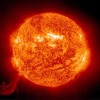Those Bad Solar Storms
CBS News reported today that solar storms may knock out our power grids, satellites, cell phone signals, and that we should take note and be prepared. NASA says the sun is going through a period of increased solar activity, creating intense sun storms, that could take down our technology. Take down? Put it out of commission. Scientists are working on a way to protect our electronic devices. See video.





